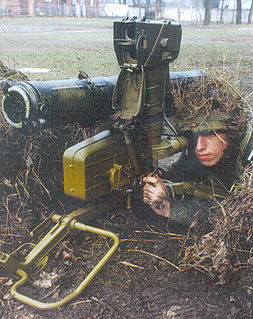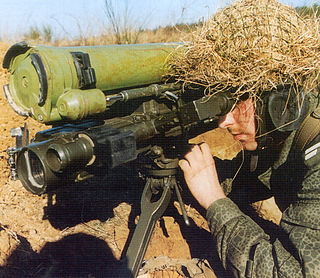
The Kamov Ka-50 "Black Shark" is a Russian single-seat attack helicopter with the distinctive coaxial rotor system of the Kamov design bureau. It was designed in the 1980s and adopted for service in the Russian army in 1995. It is manufactured by the Progress company in Arsenyev. It is used as a heavily armed scout helicopter. It is the world's first operational helicopter with a rescue ejection system.
NATO reporting names are code names for military equipment from Russia, China, and historically, the Eastern Bloc. They provide unambiguous and easily understood English words in a uniform manner in place of the original designations, which either may have been unknown to the Western world at the time or easily confused codes. For example, the Russian bomber jet Tupolev Tu-160 is simply called "Blackjack".

The 9M133 Kornet is a second generation Russian man-portable anti-tank guided missile (ATGM) intended for use against main battle tanks. It was first introduced into service with the Russian army in 1998.

The 9M14 Malyutka is a manual command to line of sight (MCLOS) wire-guided anti-tank guided missile (ATGM) system developed in the Soviet Union. It was the first man-portable anti-tank guided missile of the Soviet Union and is probably the most widely produced ATGM of all time—with Soviet production peaking at 25,000 missiles a year during the 1960s and 1970s. In addition, copies of the missile have been manufactured under various names by at least six countries.

The 3M6 Shmel is an MCLOS wire-guided Anti-tank missile of the Soviet Union. Its GRAU designation is "3M6" and its NATO reporting name is AT-1 Snapper.

The 9K111 Fagot is a second-generation tube-launched SACLOS wire-guided anti-tank missile system of the Soviet Union for use from ground or vehicle mounts. The 9K111 Fagot missile system was developed by the Tula KBP Design Bureau for Instrument Building. "9M111" is the GRAU designation of the missile. Its NATO reporting name is AT-4 Spigot.

9K114 Shturm - is a SACLOS radio guided anti-tank missile system of the Soviet Union. Its GRAU designation is 9K114. Its NATO reporting name is AT-6 Spiral. The missile itself is known as the 9M114 Kokon (Cocoon).

The 9M120 Ataka is an anti-tank guided missile (ATGM) originating from the Soviet Union. The NATO reporting name of the 9M120 missile is the AT-9 Spiral-2. It is the next major generation in the 9K114 Shturm family. The missile has radio command guidance and is also a Beam riding SACLOS. This missile's primary variant was designed to defeat tanks with composite armour and explosive reactive armor. The 9M120 Ataka system is often confused with the 9K121 Vikhr system, despite being different weapons systems developed by different companies. The former was designed by the KBM machine-building design bureau and manufactured by the Degtyarev plant. According to the Stockholm International Peace Research Institute, Russia exported the Ataka ATGM to Iran, Kazakhstan, and Slovenia.

The 9K115 Metis is a man-portable, tube launched, SACLOS wire-guided anti-tank guided missile of the Soviet Union. It is considered the Soviet counterpart to the American M47 Dragon ATGM.

The 9K112 Kobra is a SACLOS anti-tank missile system of the Soviet Union. It is fired from the 125 mm main guns of the T-64 and T-80 series of tanks. A newer design based on the same concept is the 9M119.

The 9K121 Vikhr is a Russian laser beam riding anti-tank missile. "9K121" is the GRAU designation for the missile system. The missile can be launched from warships, Ka-50 and Ka-52 helicopters, and Su-25T aircraft. It was first shown publicly at the 1992 Farnborough Airshow.

The P-270 Moskit is a Soviet supersonic ramjet powered anti-ship cruise missile. Its GRAU designation is 3M80, air launched variant is the Kh-41 and its NATO reporting name is SS-N-22 Sunburn. The missile system was designed by the Raduga Design Bureau during the 1970s as a follow up to the P-120 Malakhit. The Moskit was originally designed to be ship-launched, but variants have been adapted to be launched from land, underwater (submarines) and air, as well as on the Lun-class ekranoplan. The missile can carry conventional and nuclear warheads. The exact classification of the missile is unknown, with varying types reported. This uncertainty is due to the secrecy surrounding an active military weapon. The missile has been purchased and exported to the People's Liberation Army Navy (China) and Egyptian Navy (Egypt).

JSC Konstruktorskoe Buro Priborostroeniya (KBP) is one of the main enterprises in the field of Russian defense industry, based in Tula. It is engaged in designing high-precision weapon systems for the Army, the VMF and the VKS, as well as anti-air defense systems, high-rate-of-fire cannons and small arms, in addition to civilian products. Its full name goes as "Joint-Stock Company Instrument Design Bureau named after Academic A. G. Shipunov". Its shareholders include High Precision Systems, part of the State Corporation Rostec.

The 9K115-2 Metis-M is a Russian portable anti-tank guided missile system. "9K115-2" is the GRAU designation of the missile system. The Metis-M1 is the latest upgraded variant of Metis-M. The system is designed to augment the combat power of company-level motorized units.

The R-17 Elbrus, GRAU index 9K72 is a tactical ballistic missile, initially developed by the Soviet Union. It is also known by its NATO reporting name SS-1C Scud-B. It is one of several Soviet missiles to carry the reporting name Scud; the most prolifically launched of the series, with a production run estimated at 7,000 (1960–1987). Also designated R-300 during the 1970s, the R-17 was derived from the R-11 Zemlya. It has been operated by 32 countries and manufactured in four countries outside the Soviet Union. It is still in service with some. It's been called the Hwasong-5 in North Korea.

The Matka class is the NATO reporting name for a group of hydrofoil missile boats built for the Soviet Navy. The Soviet designation is Project 206MR Vikhr. Following the 1997 Black Sea Fleet partition treaty all Black Sea Fleet Matka class boats were passed to the Ukrainian Navy.
The 2T Stalker, also known as BM-2T Stalker, is a Belarusian armoured vehicle. It never entered production.